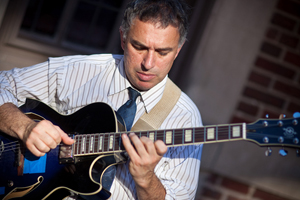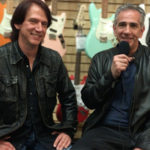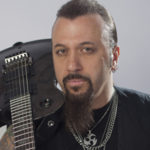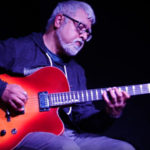Guitar virtuoso talks influences, technique and the solo gig he’s held for 25 years
By Jon Liebman
December 29, 2017
Originally from Goteborg, Sweden, Jake Reichbart is a guitarist and bandleader, highly lauded for his virtuoso solo guitar styles, as well as being one of the busiest sidemen in the Detroit area. Since first moving to Michigan in 1991, Reichbart has spent much time in Detroit recording studios, doing sessions and jingle work, in addition to thousands of live gigs, including performances for two U.S. Presidents and three Michigan Governor’s Inaugural Balls.
Jake’s passion for solo guitar came after discovering – and being heavily influenced by – guitar giants Joe Pass, Tuck Andress and Tommy Emmanuel, among others. Reichbart’s solo guitar albums, 16 Songs and Long Ago And Far Away, were both nominated for “Best Jazz Recording” by the Detroit Music Awards, and received critical acclaim from All Music Guide, Just Jazz Guitar and other notable publications, as well as radio stations throughout the U.S. and abroad.
His instructional resources, including Jake Reichbart Plays Jazz Classics and Pop Hits For Solo Guitar, published by Hal Leonard Corp., are distributed worldwide. Jake also has a popular YouTube channel, with a fan base of over 25,000 avid subscribers. We recently caught up with Jake at The Earle Restaurant in Ann Arbor, where he’s held a steady solo guitar gig for 25 years.
FGPO: You’re originally from Sweden?
JR: That’s true. I was born in Sweden. I lived in Canada, I lived in the Netherlands, I lived in Israel many years. But I’ve been here (Michigan) for 26 years and, in fact, I’ve been playing at this restaurant, The Earle, 25 out of those 26 years, weekly, so you’re catching me at my weekly gig.
FGPO: Tell me about your initial exposure to music.
JR: My older sister was a concert pianist, and she traveled the world (so) we heard classical piano in the house. Of course, I wanted to do something different, so piano lessons did not catch (on) with me. I was born in ’64 and my earliest musical memory is, literally, “Eleanor Rigby,” at age 2. After that it was Beatles, Rubber Soul, Revolver. A few years after that, my sister, even though she was a classical pianist, she was a rebel, so Cream and Clapton and Hendrix. I remember we had an old reel-to-reel tape (recorder) in the house that played non-stop: The Doors (and) the three-album set of Woodstock, the live performance. So that is my earliest memory. One album that was close to my heart from that time was the Super Session album, with Mike Bloomfield and Al Kooper, at age 3 or 4. I didn’t know it at the time, but it’s really my earliest introduction to jazz. Even though it wasn’t jazz per se, it was my earliest draw into improvised music. I had no interest in guitar in particular; I wanted to play drums. I was one of those (kids with) pots & pans and boxes and whatnot. I made up my own drum kits at home for many years. The guitar happened by accident much later, into my mid-teens, really, 14, 15. A neighbor had a guitar and I started strumming on it. It was all pop. It had nothing to do with jazz at the time. That came much later.
FGPO: Who were your influences? Did you have any guitar heroes?
JR: Well, drawing from that earlier influence, of course, George Harrison, Clapton and Hendrix and all the rock heroes of the day.
FGPO: What about all the places you lived? How much were you influenced by that music?
JR: Well, I spent several years, in my early 20s, in Amsterdam, and I lived with six or seven Cuban guys. We shared a room, in great poverty, but with great music all the time. So I was influenced by a lot of Afro-Cuban jazz. It’s nothing that you would hear in my playing today, but somehow it’s there.
FGPO: You played with Thijs van Leer.
JR: He was the flute player and organist in the band Focus. Actually, he was a mentor to me and, when I lived in Amsterdam, he invited me to play with his band. For a brief period of a few months, I got to play all those Jan Akkerman solos. When I wanted to be a professional musician, my biggest influence was Larry Carlton. My greatest ambition was always to be a studio guitarist, to be able to play any kind of part for any kind of song. And I did a lot of that work in Detroit, for the jingle business in the ‘90s, so I have, still from those days, 30 or 35 different guitars, 30 different amplifiers, Marshalls and Fenders and every kind of thing. That was my ambition in the ‘90s. That business kind of dried out. As you know, now producers have libraries of sounds and so forth. And along the way I kind of developed this interest in playing solo guitar.
FGPO: Would you say that’s primarily what you’re known for?
JR: Yes, that’s really become my thing. I just had the occasion of posting my 400th solo guitar performance on YouTube. I’ve been doing it very consistently, every Friday for the past eight years. I’ve built up an audience, maybe 25,000 subscribers or so, people who are interested in the solo guitar style. As the recording business has dwindled, the bands business is kind of off, I’ve developed more musical interest in arranging all the parts for a solo performance. That’s become my main gig, so 90% of what I do now is solo guitar.
 FGPO: By “solo,” you mean unaccompanied guitar arrangements?
FGPO: By “solo,” you mean unaccompanied guitar arrangements?
JR: I accompany myself is more accurate to say because I play the melody, the chords and the bass at the same time.
FGPO: It seems that once you hit on that system, the floodgates really opened up.
JR: Yes, I can play pretty much any song, if I heard it or if I know it. It’s not much of a mystery, really, because when I explain it, what I like to say is I have a vocabulary of solo guitar. I have my letters, words, sentences, so if you take my arrangements and break them down into very small parts, you’ll find all these parts. I played them yesterday also, and the day before, and the day before. I just rearrange them every time.
FGPO: Yet it never gets old or boring.
JR: Just like when we’re talking now, this conversation never happened before. We used all the same words in other conversations. It’s the exact same thing. Along the way, I try to build my vocabulary. I try to learn new harmonies. I try to play some voicings I’ve never played before. But even if I will never play any new voicing – which I hope does not happen – I have enough to play pretty much anything.
FGPO: Your passion also includes teaching, imparting that knowledge to others. Tell me about your instructional resources.
JR: There are two groups: The ones I produce for Hal Leonard, like you, and the ones that I produce myself, and they’re separate. The ones that I do for Hal Leonard are short segments, 15 minutes per song. So each DVD will have 8 tunes on it, or 10 tunes. They’re kind of “the facts only, ma’am” kind of thing. Just what I play and how I play it, and it’s TABBED out.
FGPO: So, melody, bass line and whatever comes in between.
JR: Yeah. And that’s great for those that want “just the facts.” And it’s a great value because you get 10 songs per one disk.
FGPO: And what about your own stuff?
JR: My own stuff is a little bit different, one song per lesson. In my lessons, I go beyond the “what” to the “how” and “why.” How I got there and how you can make your own. So there’s an option for those who want “just the facts,” through the Hal Leonard lessons, and those who want more in-depth, how I arrange.
FGPO: Tell me about your equipment.
JR: These days, I play a Bill Comins guitar, which I endorse. It’s a stunning instrument. It’s the best instrument I ever owned, and I’ve had many. It plays perfectly in tune, up and down the neck, which I’ve never experienced on a guitar.
FGPO: What about strings?
JR: The strings are D’Addario. On this guitar, I use .11 though .49, with an unwound third string.
FGPO: Other than your work as a solo guitarist, what else is keeping you busy?
JR: I still do other stuff. I’m involved with a prog rock project, called THEO. I do session work all the time. In January I have some dates with an artist whose doing a smooth jazz thing. Maybe I’ll have some dates with you – who knows?!I still play lots and lots of other gigs. I’m still a freelance guitar player in the wider Detroit region, so I work with bar bands, event bands, I play a lot of solo stuff for events, Christmas parties…
FGPO: Do you ever fool around with, say, a 7-string guitar, or anything with more – or less – than 6 strings?
JR: I actually have at home a 9-string guitar that I had built for me. You know what, there’s so much on the regular guitar that I don’t know yet, I just don’t have time. I just want to learn more on the 6-string. Maybe one day I’ll try a 7-string.
FGPO: What about the future, Jake? What else would you like to do that you haven’t already accomplished?
JR: Like I said, I still do plenty of other things. I travel every year to Europe. I play there in the summer, in France mostly, and elsewhere. I’ve been to Israel a couple times, to teach and to perform. I have three kids and we’re all very involved in hockey, of all things, so I see a lot of hockey in my future. Musically, just continuing what I’m doing. I’m 53, so I’m not the oldest, not the youngest.
FGPO: I think you still have a lot of notes left in you.
JR: A lot of notes! Most of them I will play tonight (laughs).
FGPO: What would you be if you weren’t a guitar player?
JR: Probably a carpenter or something like that. I enjoy, in my own house, doing all the repairs. I’m the only guy for blocks and blocks who owns his own cement mixer, for example. And I have every tool there is. I do woodwork, finish work, framing, drywall, plumbing, electric, gas… I do it all. Now that I do it for myself, I’m enjoying it. If I had to do it 8 hours a day, who knows?
Visit Jake’s website here.
Watch Jake’s 400th YouTube video, “Classical Gas,” here!





